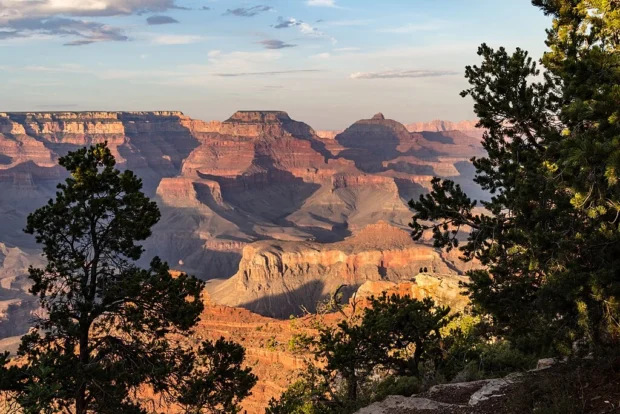The Grand Canyon, United States, stands as a colossal masterpiece shaped by millions of years of the Colorado River’s flow. This vast canyon is known worldwide for its immense size, spectacular views, and deep geological history. Visitors come here not only for the breathtaking sceneries but also for hiking, rafting, and learning about ancient cultures. If you are thinking about visiting, finding nearby accommodation like lodges, motels, or campgrounds will keep you close to the action. Local food experiences include traditional southwestern dishes and Native American specialties, available at eateries near the canyon’s rim. Transport from nearby airports such as Flagstaff Pulliam or Phoenix Sky Harbor includes shuttle services, rental cars, and buses that bring travelers right to the park entrance. Train service via the Grand Canyon Railway from Williams, Arizona, offers a nostalgic, scenic ride into the canyon area. This guide will walk you through the best ways to enjoy the Grand Canyon with practical visitor tips, fascinating history, and reservation advice.
Table of Contents
If you want to get a clearer idea about the best viewpoints, local foods, and peaceful spots in the Grand Canyon, the Grand Canyon Travel Guide provides great insights that complement what you’ve learned here.
How to Get to Grand Canyon National Park
Reaching the Grand Canyon is an adventure itself. The park is divided into two main rims: the South Rim and the North Rim. The South Rim is the most popular and accessible part, open year-round. The North Rim is less crowded but closed during winter months due to snow.
Travel Routes and Options
Driving is the most flexible way to visit. From Las Vegas, it is about a 4.5-hour drive, mainly using US-93 and US-64 highways. From Phoenix, Arizona, the drive takes roughly 3.5 to 4 hours via I-17 and AZ-64. Public transport options exist but are limited; shuttle buses run seasonally from nearby towns, and the Grand Canyon Railway departs from Williams, Arizona, heading directly to the South Rim. A few tour companies also offer daily trips from Las Vegas or Phoenix.
The Colors and Stories of Grand Canyon History
The Grand Canyon is more than a natural wonder; it is a rich tapestry of history and culture. It holds deep significance for Native American tribes such as the Havasupai, Hopi, Navajo, and Hualapai, who have lived near or within the canyon for centuries. Many ancient villages and rock art sites line the canyon walls, telling stories of past generations.
After marveling at the Grand Canyon’s vastness and history, some travelers enjoy the contrasting experience of a city landmark with strong cultural significance. The Golden Gate Bridge in San Francisco offers inspiring engineering stories and scenic urban views worth seeing next on your journey.
After enjoying the vastness and history of the Grand Canyon, visitors interested in ancient architectural marvels may appreciate the Great Wall near Beijing, another impressive site rich with stories and natural beauty.
Geologically, the canyon exposes nearly two billion years of Earth’s history through its layered rocks. The Colorado River carved the canyon over the last six million years, revealing an almost vertical timeline of Earth’s past. Early European explorers arrived in the 1540s, led by Spanish explorers, but it wasn’t until the late 19th and early 20th centuries that the area became widely known and protected as a national park in 1919.
Best Days and Times to Visit Grand Canyon
Timing your visit well can make all the difference in enjoying the Grand Canyon. Spring (March to May) and fall (September to November) offer cooler temperatures and fewer visitors, making these seasons ideal for hiking and sightseeing. Summer sees the highest crowds and can be very hot, especially at lower elevations like the Inner Gorge.
Weekdays are generally less crowded than weekends and holidays. Sunrise and sunset are magical times when the canyon’s colors change dramatically, creating unforgettable photo opportunities. The South Rim offers many points to witness these spectacular light shows, including Mather Point and Yavapai Observation Station.
Reservations and Tour Bookings for a Smooth Visit
Planning ahead can save frustration at the Grand Canyon. While general admission to the park does not require advance booking, several popular activities and accommodations do. Shuttle services around the South Rim, ranger-led programs, and specialized tours like rafting or helicopter rides usually require early reservation, especially during high season.
Camping spots inside the park are limited and often booked months in advance. If you want to hike into the canyon and stay overnight at Phantom Ranch or backcountry campsites, you must apply for permits well before your trip. This strict control helps preserve the area’s natural beauty and safety.
Quirky Details You Might Miss at Grand Canyon
- The canyon’s name may come from a Spanish word for “big gorge,” but Native peoples have their own rich names describing its spiritual and physical essence.
- There is a “phantom” village called Ancestral Puebloan ruins hidden among the cliffs, giving clues of ancient desert life.
- Despite its wide-open look, the inner canyon shelters unique plants and animals adapted to this harsh environment, including rare condors you can spot soaring above.
- Temperature can vary over 25 degrees Fahrenheit from rim to river level, so layering clothes is advised.
Official Information and Resources
For the most current details about entry fees, events, shuttle services, and alerts, check the official Grand Canyon National Park website. It offers maps, safety advice, and many downloadable guides to help you make the most of your visit.
Grand Canyon National Park Official Site

- Grand Canyon (Arizona, USA), South Rim nahe Tusayan — 2012 — 6041 by Dietmar Rabich on Wikimedia Commons – cc by-sa 4.0
